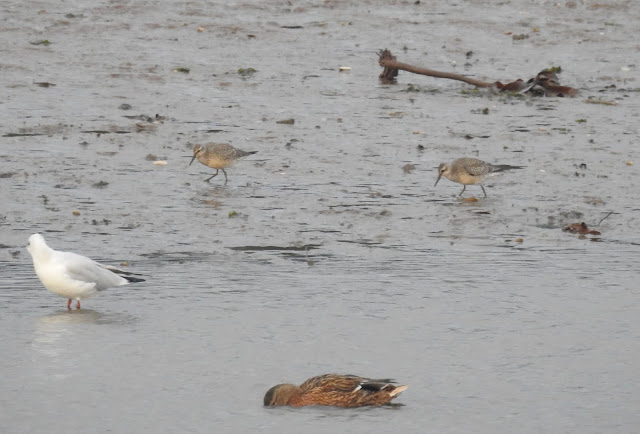Typical conditions and date for a decent 'grounding' of large Gulls on the Axe today, and I wasn't disappointed! I was so pleased to be off work today so I could get the most from it.
There's been plenty of water around so not so much has been on the river, with most action coming from the large gull flock resting in the field just south of Black Hole Marsh for most of the day. The highlight came just after 2pm when a first-winter Caspian Gull made itself know....albeit briefly!
It was such a crisp bird that despite it's briefness, and the fact I didn't even get the chance to point my camera at it, I am 'having it'. Potentially the first non-photographed Axe Casp ever (if it makes the DBRC grade that is!). It was asleep when my scope stopped on it, showing a contrasting white head, neck shawl, plain greater coverts and black tertials. I stayed on it until it finally popped its head out revealing just what I was hoping, a white head, long narrow dark bill, small eye. However, literally five seconds later it took flight and disappeared off to the north west at a hell of a speed. Am pleased to say in flight it looked just as I wanted it to as well, although sadly failed to see its underwing.
My Casp tally for the day was actually 1.5, as for the whole day a Caspian-hybrid has been present too. I saw it early this morning, early afternoon and again at last knockings. A long-winged and long-billed bird with a contrasty face and very striking tail pattern, but very Herring Gull-like coverts and scapulars. Here's a few pics...
Been a good showing of Yellow-legged Gulls today, with three in total all spending time in the gull flock south of Black Hole. A pristine adult, large second-winter and a first-winter. Take a look below for a dreadful and distant photo of the adult (two left of the Crow along the back row, compare mantle tone with the adult Herring Gull on the right)...
I haven't seen the Pink-footed Goose for a few days so think it may have finally left us. Here's my best shots of it from the 17th, although I last saw it on the 18th from a tram!
Had a couple of other decent 'work birds' lately too. The biggest surprise being on 13th when I glanced out of my office window, which is alongside the lower Estuary, to see a Great White Egret flop in and land along the Estuary right by the main road! It stayed just long enough for me to lift my phone up and take a snap, before flying off...
On 18th I had a single Cattle Egret from a tram, flying around over the track just south of Colyford Common hide. It's such a pain having to work right in the heart of the Axe Valley....






















































